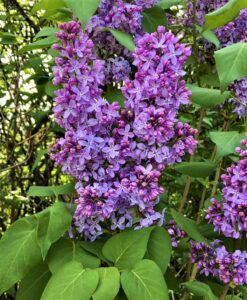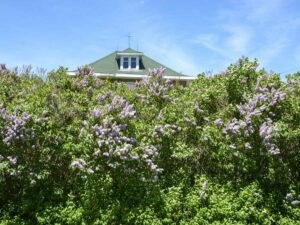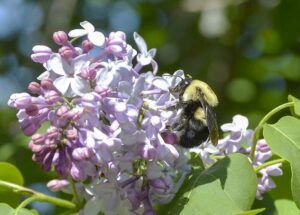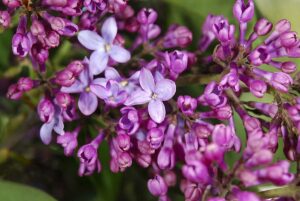MANITOULIN—Lilacs are the most popular spring-flowering shrub on Manitoulin Island. Their colourful and fragrant blossoms bring back childhood memories of visits to gardens of elderly friends and relatives.
Of all the garden plants introduced onto Manitoulin Islands from other parts of the world, perhaps the most loved is the lilac shrub. Native to the dry hills of the Balkans region of south-central Europe and Asia, they were first brought to Manitoulin Island by homesick settlers wanting a reminder of home.
Lilacs are deciduous, long-lived shrubs with multiple stems that can grow 3-5 m in height. Today they are still popular shrubs in home gardens and parks where their colourful clusters of flowers and exquisite fragrance have become harbingers of spring.
The four-petalled flowers, each about 1 cm across, are arranged in dense terminal clusters called panicles which are 8-18 cm in length. Lilacs bloom profusely for about two weeks in late May or early June, depending on the temperature.

Early settlers couldn’t have introduced a more hardy shrub as lilacs are well adapted to the conditions found on Manitoulin. Their rich green, heart-shaped leaves are rarely damaged by insects.
Lilacs grow best on alkaline soil, are long-lived, drought resistant and easy to care for. Not only do lilacs tolerate Manitoulin winters, they must be subjected to freezing temperatures for their leaf and flower buds to open in the spring.
Lilacs were planted around the homes of early settlers because they grow rapidly and their dense foliage make good wind breaks and privacy walls. Lilac shrubs persist to this day throughout Manitoulin long after the pioneers departed. They are often the only sign of past homes or settlements.

Lilacs are in the olive family and about 20 species are still found wild in their natural habitat. Several were introduced to the gardens of Europe in the 16th Century where they were modified by horticulturalists into hundreds of longer-flowering, hardy cultivars with multiple-coloured blossoms ranging from white to purple.
The colour purple is uncommon in nature and as a result, purple dyes were difficult and expensive to make. Purple gowns became symbols of royalty and wealthy people of high rank. Recall that the crown worn by King Charles III at the Coronation had purple cloth at its centre, as were portions of the clothing worn by others of the Royal Family.
Most of the lilacs grown on Manitoulin are the purple-flowered cultivars of the species Syringa vulgaris. The genus name Syringa comes from the Greek word syrinx which means ‘hollow tube.’ In ancient times, shoots of lilacs were hollowed out and made into pan flutes.
Lilacs have a special method of spreading their seeds known as ballistic dispersal, where the dry, mature seed pods open suddenly to fling the seeds in a wide radius around the plant. This allows lilacs to disperse seeds on their own without relying on animals or wind.
Lilacs do not propagate easily in the wild and do not spread from their original site. However, they do produce many suckers from the base of stems or from the roots.
Suckers are the plant’s way of rejuvenating themselves and as a result, an individual shrub with suckers can potentially live for centuries. Lilacs should be given plenty of room in gardens unless there are plans to prune them back.
Lilacs contribute to the biodiversity on Manitoulin Island as their dense growth provides protection and nesting sites for birds. Flowers of lilacs are a rich source of pollen and nectar for pollinating insects and are literally buzzing with activity in the spring.
Bumblebees and other kinds of small bees love lilacs, as do numerous species of butterflies and moths. Lilacs are an important source of nectar for the first monarch butterflies that arrive on Manitoulin Island after crossing Lake Huron with the females converting the rich nectar into eggs.

Lilacs do not respond to the amount of daylight in the spring to begin growing but rather use temperature as the main driver for bud development and flowering. The year-to-year differences in timing of lilac blooms indicates whether spring will be early or late.
Lilacs help us understand how living things are synchronized with temperature through an ecological science called phenology. Phenological studies tell us that when lilacs leaf out, it is a signal to sow cool-season vegetables such as lettuce, peas and spinach. When the lilacs bloom, it is time to plant warm-season crops such as beans and corn.
The presence of lilacs on Manitoulin Island today is a reminder that the process of colonization included more than the arrival of Europeans and their sequestering of local lands. Colonization included the introduction of shrubs such as lilacs along with many food plants such as wheat, oats, barley, onions, apples, potatoes, tomatoes, carrots, and peas.
The most important endemic food plants used by First Nations People when the Europeans arrived were corn, beans and squash. Grown in clusters as companion plants, they were known as the ‘three sisters’ and were shared with the settlers.
Tips on growing lilacs
Lilacs should be grown in full sun in well-drained soil. It is best to purchase lilacs in containers, from your garden centre, as they will likely flower soon after planting.
New shrubs for gardens can also be obtained by digging up larger sucker shoots, with their roots intact, from the base of an established shrub and planting them as you would a container-bought shrub. However, it may take several years for these shrubs to establish and flower.
Lilacs tend to flower profusely in alternate years, but can be enticed to flower annually by deadheading (cut and remove) the stems just below the flowers soon after they have faded and before the seeds have formed.
Lilacs form flower buds in the summer for blooms the following year, so it is best to cut the stems just below the flowers so the shrub will put its energy into next year’s flower buds rather than seeds.

When garden lilacs reach a height of about 2 m and the main stem is about 4 cm in diameter, it’s time to start pruning. Like most species of Island shrubs, lilacs are modular plants and are not harmed by removing some of their branches.
Pruning maintains the vigour of most cultivars and allows sunlight to reach leaves in the lower and central parts of the plant. Pruning controls size of the shrub and promotes a symmetrical shape. It also results in flowers appearing throughout the bush and not just at the top. Suckers should be removed regularly to maintain the plant’s shape.
Lilacs are prized cut flowers brought into our homes in bouquets to enjoy the sweet perfumes and colours. To lengthen the blossom times indoors, cut the woody stems in the evening and strip away the lower leaves.
Using a sharp knife or vegetable peeler, pare away about 5-7 cm of the bark at the cut end. Make a vertical slit about one cm deep at the base of the stems then place the flowering stems in a bucket of warm water overnight.
Place the flowers in a vase the next morning and bring it indoors. Memories will be formed that remain for the rest of your life!
*Joe Shorthouse is a retired professor of entomology who spends his summers on Manitoulin Island studying natural history. He is a regular contributor to The Manitoulin Expositor.





